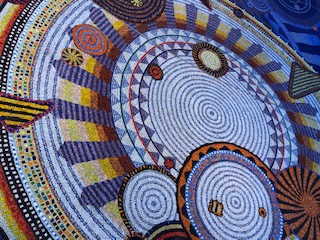 Did you know there are over 400 mosaics installed on subway platforms in the 5 boroughs of New York City? I sure didn’t until I took a subway mosaics tour with mosaic artist Cathleen Newsham and saw some of New York City’s finest.
Did you know there are over 400 mosaics installed on subway platforms in the 5 boroughs of New York City? I sure didn’t until I took a subway mosaics tour with mosaic artist Cathleen Newsham and saw some of New York City’s finest.
Subway stations don’t need colorful mosaics or installations by famous artists to have a distinctive style – but they do give commuters something fabulous to look at while waiting for their train. And New York’s transit system doesn’t disappoint, particularly if you are really paying attention. In fact, New York’s subway stations are an excellent showcase for the successful collaborations between artists, fabricators, architects and designers and the MTA itself.
The first stations, inspired by the City Beautiful theory of urban planning which had reached their peak following the 1893 Columbian Exposition, were designed by the architectural firm Heins and LeFarge. The firm created the original Beaux Arts stations and decorated the platforms with elaborate arts and crafts style glazed terra-cotta bas-reliefs and mosaics, depicting almost as an afterthought, the name of the station.
 Heins and LeFarge were part of the Arts and Crafts movement and knew what materials would stand up well to heavy duty cleaning and scrubbing. They worked in ceramics to depict colorful pictorial motifs relevant to the station’s location. For example, the South Ferry station is decorated by 15 bas relief representations of a sailing ship on the water; Astor Place is decorated with large ceramic beaver emblems, representing the beaver pelts that helped make John Jacob Astor very wealthy; and the West 81st Street stop has a bas relief seascape relating to the Museum of Natural History – all created by Heins and Lefarge. The tiles use something called a “faience” glazing that produces an opaque, glazed ceramic, fired twice as opposed to single fired terra cotta, achieving an incredible range of color.
Heins and LeFarge were part of the Arts and Crafts movement and knew what materials would stand up well to heavy duty cleaning and scrubbing. They worked in ceramics to depict colorful pictorial motifs relevant to the station’s location. For example, the South Ferry station is decorated by 15 bas relief representations of a sailing ship on the water; Astor Place is decorated with large ceramic beaver emblems, representing the beaver pelts that helped make John Jacob Astor very wealthy; and the West 81st Street stop has a bas relief seascape relating to the Museum of Natural History – all created by Heins and Lefarge. The tiles use something called a “faience” glazing that produces an opaque, glazed ceramic, fired twice as opposed to single fired terra cotta, achieving an incredible range of color.
Squire Vickers took over the system’s architecture in 1908, creating the most recognizable signage in the NYC subway system. Vickers simplified the decorative borders surrounding the name tablets, did away with bas relief terra cotta signs for the ease of maintenance, and created a substantial number of decorative borders which run across the top of the tiled walls of the stations. His most distinctive style of a rectangular area with multiple inset borders of contrasting colors, in the Beau Arts typeface – were based on the “slab -serif “ fonts of the turn of the century. The best examples of his work are found on the IRT Lexington Avenue line, served by the 4, 5 and 6 trains.
But ceramic tiles unfortunately do not stand up well to the vibrations of the subway, and many of them have cracked. Consequently, mosaic tiles made up of “ italian smalti” a durable and richly colored glass, is currently the main material for subway station design. The smalti tiles are adhered to mesh, shipped to the job site and mounted on a cartoon, the outlines of which are already carved into the walls of the stations. These mosaics have incredible color, are much more flexible and able to withstand the intensity of vibrating trains.
 Our guide, Cathleen Newsham took us to see some of the finest examples of subway mosaic art. She herself was involved in creating the ceiling of the 34th Street Hudson Yards station, with its incredible swirls of color – it is a masterpiece.
Our guide, Cathleen Newsham took us to see some of the finest examples of subway mosaic art. She herself was involved in creating the ceiling of the 34th Street Hudson Yards station, with its incredible swirls of color – it is a masterpiece.
Newsham designed and fabricated a unique, creative and functional bathroom mural for a New York City client, who had a passion for roller coasters! Inspired by the mosaics that decorate the walls of New York’s subway stations, she created a mosaic mural of the Coney Island roller coaster for the back wall of a bathtub. A photo of this masterpiece can be found at
If you have a passion that you would like to see created into a functional or decorative piece of art, please contact me at https://fresheyesforyourhome.com/ so that I can help you interpret your idea. In the meantime, do take a trip on New York City’s subway lines to see these magnificent pieces of art yourself. All it costs is a swipe!




